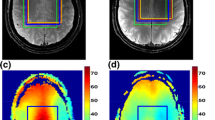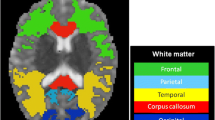Abstract
Method
This paper presents methods of measuring the longitudinal relaxation time using inversion recovery turbo spin echo (IR-TSE) and magnetization-prepared rapid gradient echo (MPRAGE) sequences, comparing and optimizing these sequences, reporting T 1 values for water protons measured from brain tissue at 1.5, 3, and 7T. T 1 was measured in cortical grey matter and white matter using the IR-TSE, MPRAGE, and inversion recovery echo planar imaging (IR-EPI) pulse sequences.
Results
In four subjects the T 1 of white and grey matter were found to be 646±32 and 1,197±134ms at 1.5T, 838±50 and 1,607±112ms at 3T, and 1,126±97, and 1,939±149ms at 7T with the MPRAGE sequence. The T 1 of the putamen was found to be 1,084±63ms at 1.5T, 1,332±68ms at 3T, and 1,644±167ms at 7T. The T 1 of the caudate head was found to be 1,109± 66ms at 1.5T, 1,395±49ms at 3T, and 1,684±76ms at 7T.
Discussion
There was a trend for the IR-TSE sequence to underestimate T 1 in vivo. The sequence parameters for the IR-TSE and MPRAGE sequences were also optimized in terms of the signal-to-noise ratio (SNR) in the fitted T 1. The optimal sequence for IR-TSE in terms of SNR in the fitted T 1 was found to have five readouts at TIs of 120, 260, 563, 1,221, 2,647, 5,736ms and TR of 7 s. The optimal pulse sequence for MPRAGE with readout flip angle = 8° was found to have five readouts at TIs of 160, 398, 988, 2,455, and 6,102ms and a TR of 9 s. Further optimization including the readout flip angle suggests that the flip angle should be increased, beyond levels that are acceptable in terms of power deposition and point-spread function.
Similar content being viewed by others
References
Paus T (2005) Mapping brain maturation and cognitive development during adolescence. Trends Cogn Sci 9: 60–68
Paus T, Collins D, Evans A et al (2001) Maturation of white matter in the human brain: a review of magnetic resonance studies. Brain Res Bull 54: 255–266
Koenig S, Brown R, Spiller M et al (1990) Relaxometry of brain—why white matter appears bright in MRI. Magn Reson Med 14: 482–495
Rooney WD, Johnson G, Li X et al (2007) Magnetic field and tissue dependencies of human brain longitudinal (H2O)–H- relaxation in vivo. Mag Reson Med 57: 308–318
Deichmann R, Good CD, Josephs O et al (2000) Optimization of 3-D MP-RAGE sequences for structural brain imaging. Neuroimage 12: 112–127
Kiefer B (1998) Turbo spin echo imaging. In: Schmitt F, Stehling MK, Turner R(eds) Echo planar imaging. Theory, technique and applications. Springer, Berlin, pp 583–604
Kurland RJ (1985) Strategies and tactics in NMR imaging relaxation-time measurements. 1 Minimizing relaxation-time errors due to image noise–the ideal case. Magn Reson Med 2: 136–158
Weiss GH, Gupta RK, Ferretti JA et al (1980) Choice of optimal parameters for measurement of spin-lattice relaxation-times. 1. Math Formul 37: 369–379
Crawley AP, Henkelman RM (1988) A comparison of one-shot and recovery methods in T1-imaging. Magn Reson Med 7: 23–34
Zaitsev M, Steinhoff S, Shah NJ (2003) Error reduction and parameter optimization of the TAPIR method for fast T-1 mapping 49: 1121–1132
Lin MS, Fletcher JW, Donati RM (1986) 2-Point T1 measurement—wide-coverage optimizations by stochastic simulations 3: 518–533
Freeman A, Gowland P, Mansfield P (1998) Optimization of the ultrafast look-locker echo-planar imaging T-1 mapping sequence. Magn Reson Imaging 16: 765–772
Ordidge RJ, Gibbs P, Chapman B et al (1990) High-speed multislice T1 mapping using inversion-recovery echo-planar imaging. Magn Reson Med 16: 238–245
Gowland PA, Leach MO (1991) A simple method for restoration of the signal polarity in multi-image inversion recovery sequences for measuring T1. Magn Reson Med 18: 224–231
Press WH, Teukolsky SA, Vettering WT et al (1995) Numerical recipies in C, 2nd edn. Cambridge University Press, London
Yarnykh VL (2007) Actual flip-angle imaging in the pulsed steady state: a method for rapid three-dimensional mapping of the transmitted radiofrequency field. Magn Reson Med 57: 192–200
Bakker C, Degraaf C, Vandijk P (1984) Derivation of quantitive information in NMR imaging—a phantom study. Phys Med Biol 29: 1511–1525
Fischer H, Rinck P, Van Haverbeke Y et al (1990) Nuclear relaxation of human brain grey and white matter: analysis of field dependence and implications for MRI. Magn Reson Med 16: 317–334
Meara SJP, Barker GJ (2007) The impact of magnetization transfer effects on inversion recovery sequences using a fast spin echo readout. International Society of Magnetic Resonance in Medicine, p 1818
Mitchell C, Truong T, Ibrahim T et al (2003) Accurate T1 measurements at 8Tesla despite radiofrequency inhomogeneity. Proc Int Soc Mag Reson Med, Toronto, p 1089
Ikonomidou V, Gelderen Pv, Zwart JD et al (2006) T1 measurements at 7T with application to tissue specific imaging. Proc Int Soc Mag Reson Med, Seattle, p 921
Li T, Deoni C (2006) Fast T1 mapping of the brain at 7T with RF calibration using three point DESPOT1 method. Proc Int Soc Mag Reson Med, Seattle, p 2643
Gelman N, Ewing J, Gorell J et al (2001) Interregional variation of longitudinal relaxation rates in human brain at 3.0 T: Relation to estimated iron and water contents. Magn Reson Med 45: 71–79
Lu H, Nagae-Poetscher L, Golay X et al (2005) Routine clinical brain MRI sequences for use at 3.0Tesla. J Magn Reson Imaging 22: 13–22
Vymazal J, Righini A, Brooks R et al (1999) T1 and T2 in the brain of healthy subjects, patients with Parkinson disease, and patients with multiple system atrophy: Relation to iron content. Radiology 211: 489–495
Author information
Authors and Affiliations
Corresponding author
Rights and permissions
About this article
Cite this article
Wright, P.J., Mougin, O.E., Totman, J.J. et al. Water proton T 1 measurements in brain tissue at 7, 3, and 1.5T using IR-EPI, IR-TSE, and MPRAGE: results and optimization. Magn Reson Mater Phy 21, 121 (2008). https://doi.org/10.1007/s10334-008-0104-8
Received:
Revised:
Accepted:
Published:
DOI: https://doi.org/10.1007/s10334-008-0104-8




